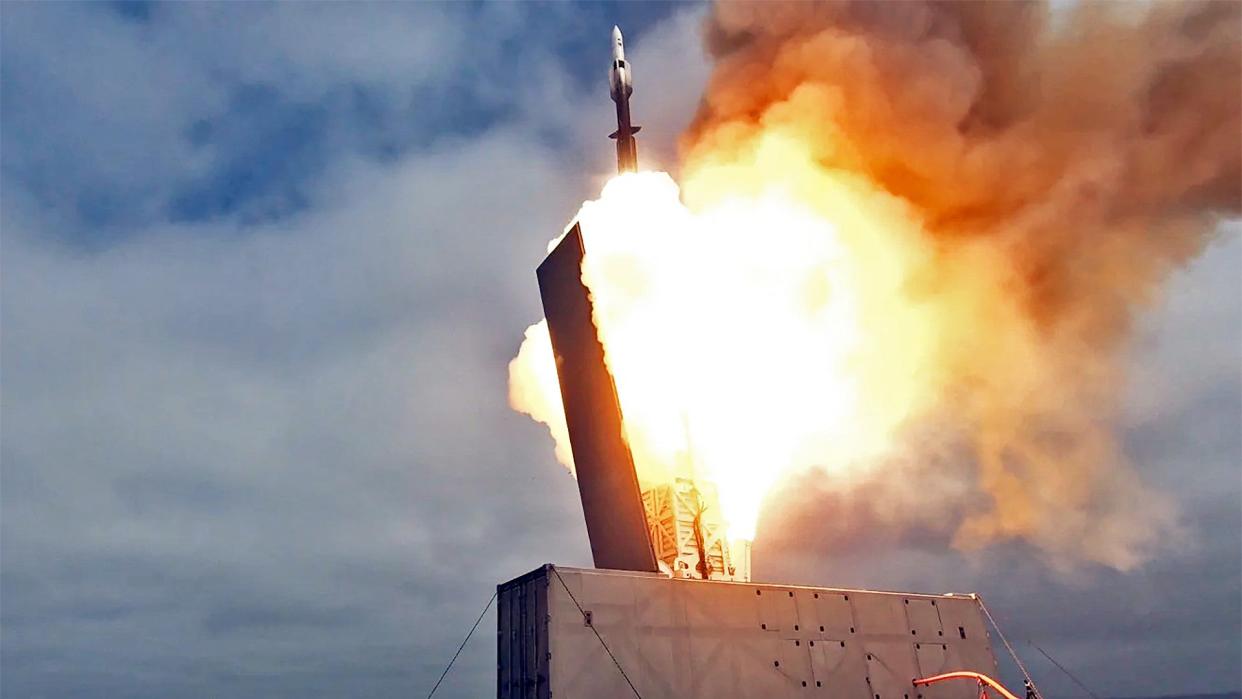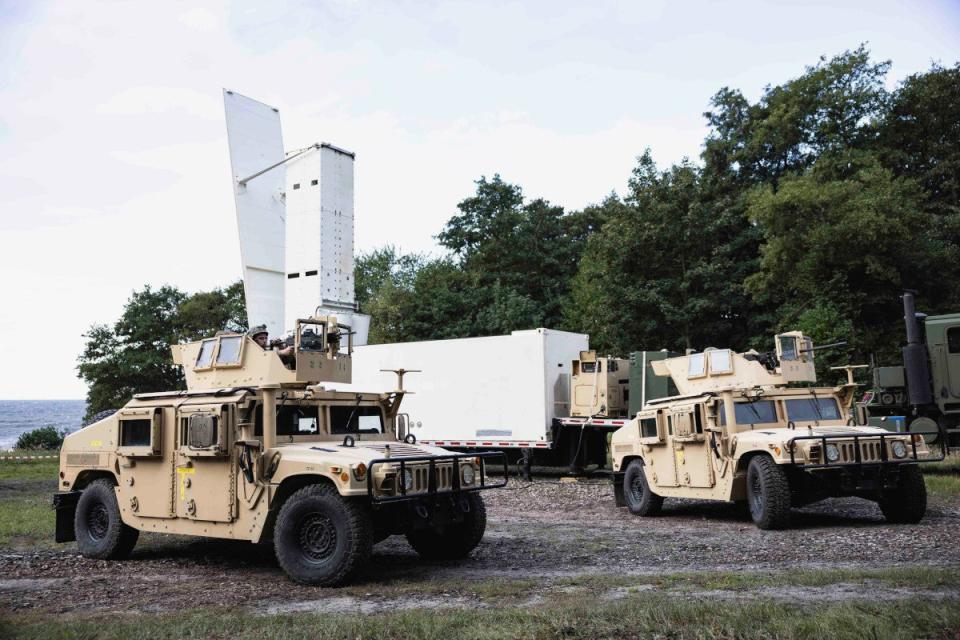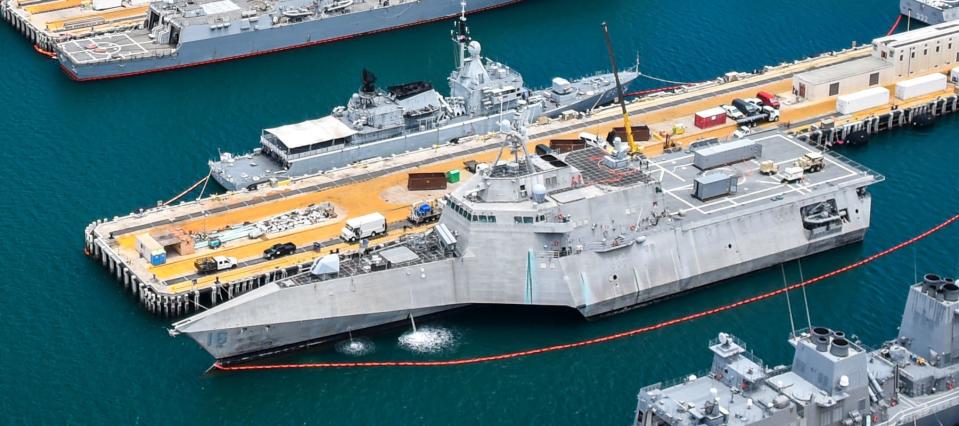SM-6 Missile Fired From Littoral Combat Ship

The U.S. Navy has demonstrated its ability to fire an SM-6 missile at a surface target from a Littoral Combat Ship (LCS) using a containerized system that can also be used to launch Tomahawk cruise missiles. The test points to new possibilities for the service when it comes to employing its beleaguered LCS fleets, including during potential higher-end conflicts. The Navy also says it is looking into integrating this containerized launcher, which has already been tested on a large uncrewed surface vessel and in a ground-based format, on other "afloat platforms."
Naval Surface Forces, U.S. Pacific Fleet announced late last night that the Independence class LCS USS Savannah had carried out the live-fire test in the Eastern Pacific Ocean. The SM-6 was fired at "a designated target" and "demonstrated the modularity and lethality of Littoral Combat Ships and the ability to successfully integrate a containerized weapons system to engage a surface target," according to an official statement.
https://www.youtube.com/watch?v=GqMyrbKM8wI
Savannah employed what is formally known as the Mk 70 Mod 1 Expeditionary Launcher, or a variant or derivative thereof, for this test, as seen in the picture at the top of this story. This containerized launch system is derived from the Mk 41 Vertical Launch System (VLS) used on many U.S. Navy and foreign warships, and can also be used to fire land-attack, anti-ship optimized, and other variants of the Tomahawk cruise missile.
The Navy has previously test-fired an SM-6 from a Mk 70-series launcher onboard the Ranger, an experimental large uncrewed surface vessel. The service has also shown its ability to utilize these launchers in a trailer-mounted configuration on land, including in an exercise in Denmark back in September. The Mk 70 family is also related to the U.S. Army ground-based Typhon system, which can fire SM-6s and Tomahawks, as well.
https://twitter.com/DeptofDefense/status/1433852377870839808

Ship spotters first noticed USS Savannah leaving its homeport of San Diego, California with the containerized launch system, as well as what looked to be a trailer-mounted AN/TPQ-53 radar, on its rear flight deck back on September 26.
https://twitter.com/WarshipCam/status/1706711962418102720?s=20
It is unknown what the specific purpose of the radar was in this instance, but it might have been used to help cue the SM-6 to its target. Also known as the Counterfire Target Acquisition Radar, the AN/TPQ-53 is primarily designed to spot and track incoming rockets and artillery rounds, and then determine their points of launch so friendly forces can launch so-called counter-battery strikes. It has also demonstrated an ability to detect and track drones.
Interestingly, this is not the first time an Independence class LCS has been seen with the same launcher/radar combination. A picture of U.S. Navy and foreign warships in port at Pearl Harbor in Hawaii during last year's Rim of the Pacific (RIMPAC) exercise shows the USS Tulsa equipped in this same way. The Navy made no specific announcement about this ship and its loadout at the time and it is unknown Tulsa fired any missiles using this system during RIMPAC 2022.

When asked for more specifics about yesterday's test, a spokesperson for the U.S. Pacific Fleet told The War Zone that no more information beyond what was in the initial statement was currently releasable. They did, however, confirm that the Navy has previously tested "containerized weapons systems at sea" and that the test launch from Savannah is part of broader "ongoing experimentation and integration of these systems" on platforms including, but not limited to LCS.
Whatever the case, the Mk 70 family does offer a relatively simple way to increase the firepower on a wide variety of ships with suitable deck space. This includes smaller surface combatants with helipads like Independence class LCSs, various amphibious warfare, and certain auxiliary support ships, including commercial designs. The containerized launcher provides immense flexibility just with its ability to fire SM-6s and Tomahawks, and its Mk 41 VLS heritage means more munition options could definitely be integrated in the future.
The SM-6 is a multi-purpose weapon that can be employed against a wide variety of air and surface targets. Some existing variants of the missile are even capable of engaging traditional ballistic missiles and more novel hypersonic threats in the terminal stages of their flight. An enlarged version, the SM-6B Block IB, is currently in development and is expected to offer hypersonic peak speed and greater range.
https://www.youtube.com/watch?v=0OU1pUyIzTw
"The containerized SM-6 launcher ... dramatically increases the Navy's flexibility to move and employ the weapon systems at anytime [sic] - anywhere - in the best interests of the United States, and our Allies and partners," a spokesperson for U.S. Naval Forces Europe-Africa told The War Zone after the demonstration of the ground-based version of the system in Denmark earlier this year. "An SM-6 is capable of combating threats such as fixed-wing planes, helicopters, and cruise missiles, while also being able to intercept ballistic missiles during their terminal phase of flight."
"In addition, SM-6 also has a secondary strike capability, and is able to hit fixed targets on land and moving targets, such as ships, at sea with great precision over long ranges," they added. "Its high-speed and quasi-ballistic missile mode of attack makes it hard to defend against."
Adding Tomahawk missiles to the mix only increases the system's capabilities and flexibility. A ship with a Mk 70-series launcher loaded with these cruise missiles would be able to hold targets on land and at sea at risk anywhere within an area extending some 1,000 miles or more out in all directions.
The video below shows the launch of a Tomahawk cruise missile in 2019 from a ground-based launcher that immediately preceded the development of the Mk 70 series.
https://www.youtube.com/watch?v=-zbEG989BKQ
Add-on sensor systems, like the AN/TPQ-53 radar, could help improve the ability of ships with Mk 70 to spot and engage various threats independently, regardless of their built-in capabilities. Robust distributed networks, like the Cooperative Engagement Capability (CEC) package the Navy has already been using operationally for years, would allow other targeting information to flow in from other offboard sources, too. The Navy long ago demonstrated the ability of ships to engage targets they cannot directly 'see' using SM-6 missiles with the help of data provided by aircraft flying above.
https://www.youtube.com/watch?v=jHHrQSFWh1I
Altogether, this could help the Navy readily increase the total number of available ships with long-range air and missile defense and strike capabilities, if required.
This is particularly significant for the service's long-troubled LCS fleets, which it continues to struggle to find missions for and that remain too vulnerable for independent operations in even middle-tier threat environments. The Navy has been in the process of integrating the Naval Strike Missile (NSM) anti-ship cruise missile onto its Independence class ships and still plans to do the same for what will remain of its fleet of Freedom class LCSs. However, the NSM, while very capable, is nowhere near as flexible as the SM-6 and has a far shorter range compared to that of the Tomahawk.
https://www.youtube.com/watch?v=GSdPBxILCTc
With regard to the Navy's LCSs, it is worth noting that using the rear flight deck as a place to mount a Mk 70-series launcher and other associated equipment eliminates their ability to launch and recover helicopters. The service has long touted the ability of the ships to carry MH-60R Sea Hawk helicopters, as well as MQ-8C Fire Scout drone helicopters, as key to helping the ships find and engage targets at extended ranges, defend against close-in threats like small boat swarms, and just provide increased situational awareness.
Still, loaded with Mk 70-series launchers and additional sensors, Independence and Freedom class LCSs, as well as other suitable surface vessels, could provide very valuable additional firepower as part of larger surface action groups. This would also allow the Navy to distribute these capabilities to a greater degree, which would present an opponent with an increased number of threats across a broader area, complicating their defensive planning and other operational decision-making processes.
This all could be particularly useful in any potential future high-end conflict, such as one against China in the Pacific. In a scenario like that, larger surface warships with Mk 41 VLSs will immediately be in high demand to defend against a host of air and missile threats and to help prosecute stand-off strikes against a high volume of targets at sea and ashore.
The Navy's demonstrating its ability to strike a surface target with an SM-6 missile fired from a containerized launcher onboard the USS Savannah looks to be a sign of many things to come, and an especially important development for the LCS fleets.
Contact the author: joe@thedrive.com

